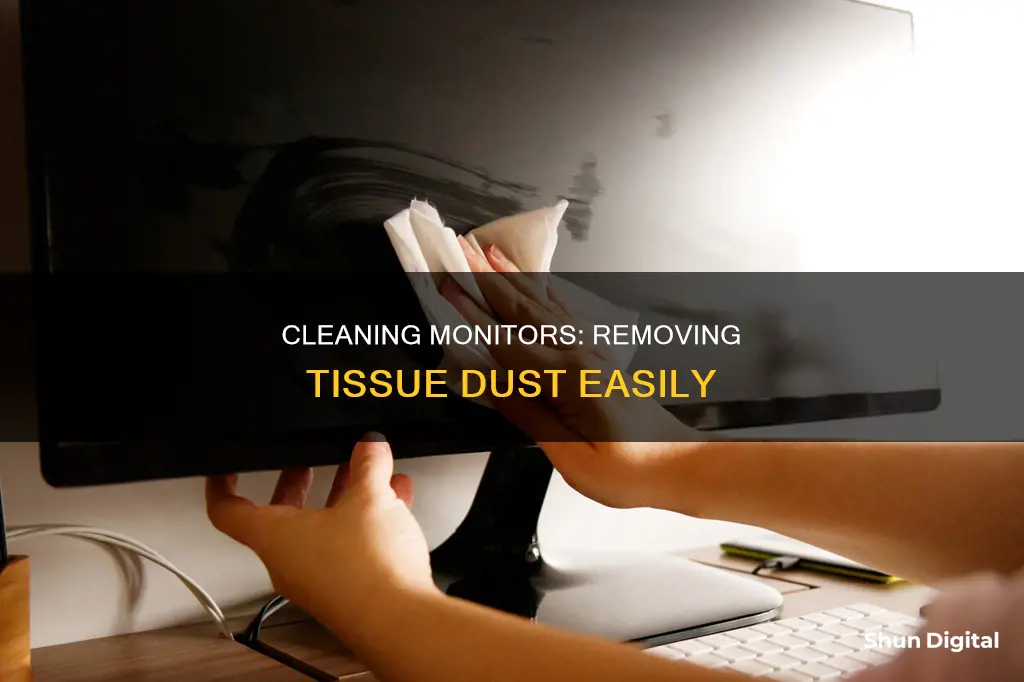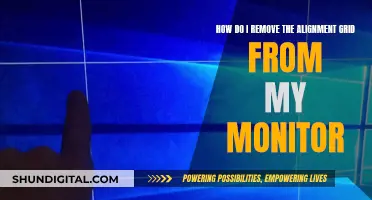
Dust and grime on your monitor can be annoying and affect your viewing experience. Luckily, there are several ways to keep your monitor dust-free and clean. Firstly, it is important to note that you should not use paper towels, tissues, or standard cleaning products like Windex on your monitor, as these can damage the screen. Instead, opt for a microfiber cloth to wipe away dust and a damp sponge for more stubborn dirt and grime. For oily residue, a cleaning solution of distilled water and isopropyl alcohol or vinegar can be used. Always remember to unplug your monitor before cleaning and avoid getting any liquid inside the device.
| Characteristics | Values |
|---|---|
| Step 1 | Shut down your monitor and unplug it from its power source. |
| Step 2 | Use a microfiber cloth to wipe the screen gently in one direction. |
| Step 3 | Repeat Step 2 until the screen is dust-free. |
| Alternative Steps | |
| Use a duster that collects dust, like Swiffer dusters. | |
| Use a damp sponge with distilled, deionized, or filtered water. | |
| Use a cleaning solution, such as 50% distilled water and 50% white vinegar, on a microfiber cloth. |
What You'll Learn

Use a microfiber cloth to wipe away dust
Microfiber cloths are a great way to remove dust from your monitor. They are designed to remove dust and debris without producing lint or scratching delicate surfaces.
Before you start, ensure your hands are clean and dry, so as not to transfer any natural hand oils onto the screen. Then, turn off your monitor and unplug it from its power source. If possible, remove the battery. This will make it easier to see the dust and ensure that no electrical issues occur.
Now, take your microfiber cloth and gently wipe the screen in one direction. Avoid scrubbing or wiping in circles, as this could damage the display or simply move the dust particles around. Continue wiping until the display is dust-free.
If you have a lot of dust built up, you can try using a duster, like the ones made by Swiffer. Just be sure to turn off your monitor before using it and avoid feather-style dusters, which simply push dust into a cloud.
Microfiber cloths are inexpensive, so it's a good idea to have several to rotate between washes. Once a cloth is full of dust, it stops being useful for cleaning.
Discovering Your Locked Ricoh Web Image Monitor Password
You may want to see also

Avoid paper towels, tissue paper, and paper towels
Paper towels, tissue paper, and paper towels might seem like a good idea to clean your monitor, but they can do more harm than good. These materials are designed to be highly absorbent, and while that's great for cleaning up spills, it's not so great for delicate electronics.
Firstly, let's talk about the composition of these materials. Paper towels are made from plant fibres, just like other types of paper. However, paper towels are treated with a special resin that makes them stronger when wet. This is why they don't tear as easily as tissue paper or notebook paper. This resin, along with the additives that enhance absorbency, can leave residue on your monitor. Over time, this residue can build up and affect the performance of your screen.
Secondly, paper products are designed to be absorbent, which means they have tiny air pockets in their fibres. These air pockets are great for soaking up liquids, but they can also trap dust and dirt. So, when you wipe your monitor with a paper towel, you're actually just pushing dust and dirt around, and potentially grinding it into the screen with the paper's rough texture. This can lead to scratches and permanent damage to your monitor.
Additionally, paper products are often made with wood pulp, which contains natural abrasives like clay and sand. These abrasives can be gentle enough on your skin, but they can be far too harsh for a delicate screen. It's like using fine sandpaper on your monitor!
So, what should you use instead? Well, a microfiber cloth is always a good option. Microfiber cloths are designed to remove dust and debris without producing lint or scratching surfaces. They're soft, gentle, and won't leave any residue behind. If you need to tackle stubborn dirt or grime, you can dampen your microfiber cloth with distilled water or a mixture of distilled water and white vinegar. Just be sure to wring it out well before wiping your screen.
In summary, paper towels, tissue paper, and other paper products might seem soft and harmless, but they can be extremely abrasive and damaging to your monitor. To keep your screen clean and scratch-free, it's best to stick to purpose-made cleaning tools like microfiber cloths.
Blind Spot Monitoring: Standard Feature on All Nissan Rogues?
You may want to see also

Use a damp sponge for dirt and grime
To remove tissue dust from your monitor, you can use a damp sponge to tackle dirt and grime. Here's a step-by-step guide:
Step 1: Power Down and Prepare
Start by shutting down your laptop or monitor. Unplug it from its power source, and if possible, remove the battery. This step is important for safety and will also make it easier to see the dust and dirt on your screen. If you're concerned about potential drips, place something lightweight and non-absorbent over your keyboard, such as a plastic sheet.
Step 2: Prepare the Sponge
Use a brand-new household sponge, not the abrasive kind. Wet the sponge with distilled, deionized, or filtered water. Avoid using standard tap water, as it may contain unseen minerals that can scratch your display. Wring out the sponge to eliminate drips and ensure a gentle cleaning experience.
Step 3: Gently Wipe the Screen
Use the damp sponge to gently wipe the affected areas of your screen. Be cautious and gentle to avoid applying too much pressure, as this could damage the display. Watch for drips, and clean them up immediately to prevent liquid from reaching sensitive components.
Step 4: Allow the Screen to Dry
Once you've cleaned the desired areas, wait for the display to completely dry before closing the lid or using your device. This step is crucial to prevent moisture-related electrical damage. You can gently wipe the screen with a dry microfiber cloth or let it air dry.
Tips and Precautions:
- Always use gentle, broad strokes when wiping your screen to avoid streaking and damaging the display.
- Never spray or pour cleaning fluid directly onto the screen. Instead, apply it to your sponge or cloth to avoid excess liquid reaching sensitive components.
- If you're concerned about scratches, consider investing in a screen protector for your monitor.
Connecting Monitors to Home Security Cameras: A Step-by-Step Guide
You may want to see also

Avoid tap water due to unseen minerals
If you're looking to remove dust from your monitor, it's important to remember that computer screens are sensitive and require special care. Here are some detailed tips to help you effectively remove dust from your monitor while avoiding the use of tap water due to unseen minerals that can cause scratches:
Use a Microfiber Cloth:
Microfiber cloths are designed to remove dust and debris without producing lint or scratching delicate surfaces. Make sure the cloth is clean and soft, and gently wipe the screen in one direction, avoiding circular motions or scrubbing.
Shut Down and Unplug Your Device:
Before you start cleaning, it's important to turn off your device and unplug it from its power source. If possible, remove the battery as well. This will make it easier to see the dust on a black screen, and it will also reduce the risk of electrical issues or shock during cleaning.
Avoid Tap Water:
Do not use standard tap water to clean your monitor. Tap water often contains unseen minerals that can scratch your display. Instead, opt for distilled, deionized, or filtered water if you need to use water at all.
Use a Screen Cleaner:
There are special screen cleaning solutions available that are designed for laptop screens. You can also make your own by mixing equal parts distilled water and isopropyl alcohol or white vinegar. Never spray the solution directly onto the screen. Instead, spray it onto the microfiber cloth and then gently wipe the screen.
Try Dry-Wiping First:
Before using any liquid or solution, try dry-wiping the monitor with a soft, lint-free cloth first. This can effectively remove dust without the need for additional liquids, reducing the risk of damage.
Avoid Chemicals:
Do not use cleaning solutions that contain ammonia, acetone, or ethyl alcohol, as these chemicals can damage the coating on LCD screens. Always read the labels of any cleaning products before using them on your monitor.
Wipe Gently:
LCD monitors and laptop screens are extremely sensitive. Avoid applying too much pressure when cleaning, as it can result in irreparable damage to the screen and even destroy pixels.
Clean Regularly:
To maintain a clear display and avoid dust buildup, make it a habit to clean your monitor regularly. This will also help prevent fingerprint smudges and other types of dirt from accumulating.
Unplug Before Cleaning:
Always unplug your device before cleaning it. This will not only make it easier to see the dust but also reduce the chances of getting shocked if you are using a liquid cleaning solution.
Avoid Paper Towels and Tissues:
While they may seem soft, paper towels and tissues are extremely rough on scratch-prone displays. They can easily scratch or damage your monitor, so it's best to avoid using them altogether.
Use a Duster:
If the dust buildup is light, you can use a duster to remove it. Avoid feather-style dusters that simply push dust around. Instead, opt for dusters that collect dust, such as those made by Swiffer. Remember to turn off your device before using a duster.
By following these tips and taking a cautious approach, you can effectively remove dust from your monitor while avoiding the potential damage that unseen minerals in tap water can cause.
Monitoring Data Usage: Turning Off Application Tracking
You may want to see also

Use a cleaning solution for oils and sticky substances
If you have dust on your monitor, it is advisable to first shut down your device and gently wipe the screen with a clean, dry, microfiber cloth. However, if you are dealing with oils or sticky substances on your monitor, a simple wipe-down may not be sufficient. Here is a detailed guide on how to use a cleaning solution to tackle such stubborn stains:
Firstly, it is imperative to choose the right cleaning solution. Avoid using any harsh chemicals, household cleaners, or soap, as these can damage your screen. Instead, opt for a screen-cleaning spray specifically formulated for electronics. Alternatively, you can create your own cleaning solution by mixing equal parts distilled water with either white vinegar or isopropyl alcohol. If you prefer a milder approach, a tiny drop of dish detergent in distilled water will also do the trick.
Once you have prepared or purchased your cleaning solution, it is now time to apply it. Start by turning off your device and unplugging it from its power source. If possible, remove the battery to prevent any electrical issues. Cover your keyboard with something lightweight and non-absorbent to protect it from any potential drips.
The next step is to apply the cleaning solution to your microfiber cloth. Be sure to dampen the cloth rather than soaking it. Never spray or pour the cleaning solution directly onto your screen, as this can cause damage. Gently rub the dampened cloth over the affected area in small circles to avoid streaks. Be careful not to press too hard, as this can distort the screen permanently.
Repeat the process until the screen is completely free of moisture. Check your keyboard and any attached hardware for any liquid pooling and clean up any excess drips. As a final precaution, let the screen air dry for about half an hour before closing it and turning on your device.
By following these steps, you can effectively remove oils and sticky substances from your monitor without causing any harm to its delicate surface.
Upgrading to a 144Hz Monitor: Is It Worth the Investment?
You may want to see also
Frequently asked questions
First, turn off your monitor and unplug it from the power source. Then, use a soft, lint-free cloth to dry-wipe the monitor. If the dust doesn't come off, try using a damp sponge or a cloth with a cleaning solution.
It is recommended to use a microfiber cloth to clean your monitor. Do not use paper towels, tissue paper, or old rags, as these can scratch the screen.
You can make your own cleaning solution by mixing equal parts distilled water and isopropyl alcohol. Alternatively, you can use a 50/50 mixture of distilled water and white vinegar. Do not use any cleaners with alcohol or ammonia, as they can damage the screen.
Always unplug your monitor before cleaning it. Do not spray the cleaning solution directly onto the screen. Instead, spray it onto the cloth and then wipe the screen.







